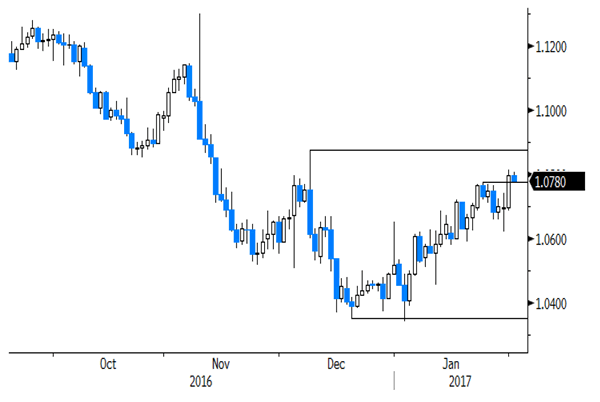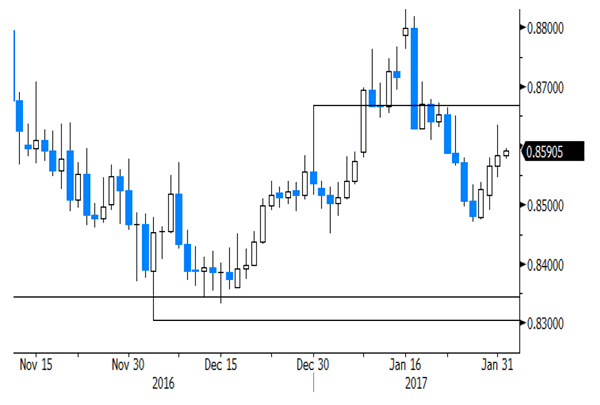Sunrise Market Commentary
- Rates: Fed statement will probably sound more hawkish
The US calendar is interesting with ADP employment report and manufacturing ISM, but they will be overshadowed by tonight’s FOMC meeting. We expect an unchanged policy without hints to a March rate hike. The wording of the statement will be more hawkish. We only anticipate big market moves in case of a deviation from this ploy. - Currencies: Trump administration ‘attacks’ trading partners on weak currency
Yesterday, the dollar declined as US president Trump and an one of his advisers openly accused Germany, China and Japan on keeping their currencies artificially weak. Today, the focus is on the Fed’s policy statement. Will the Fed statement be hawkish enough to counterbalance the recent USD negatives coming from the Trump administration?
The Sunrise Headlines
- The S&P 500 and Nasdaq ended nearly unchanged while the Dow Jones underperformed (-0.5%). Overnight, most Asian stock markets eke out gains up to 0.50%. Strong Apple earnings are supportive.
- Apple snapped out of 3 straight quarters of falling revenue as strong demand for the iPhone 7 raised investors’ hopes that the technology giant is emerging from its roughest period since it reinvented the market for mobile devices.
- China’s manufacturing sector saw growth slightly soften in January (PMI: 51.3 from 53.4). Sub-indices for both output (53.1) and new orders (52.8) registered slower growth. Chinese services expansion increased (PMI: 54.6 from 54.5).
- US President Trump and a top economic adviser unleashed a barrage of criticism against Germany, Japan and China, saying the three key US trading partners were engaged in devaluing their currencies to the harm of American companies and consumers.
- Britain’s economy now looks set to slow only slightly in 2017 after its resilient response to last year’s Brexit vote, NIESR said. Its latest forecasts pointed to growth of 1.7% this year, only a moderate slowdown from 2% in 2016.
- US President Trump picked Judge Gorsuch as nominee to the Supreme Court, a choice that would fill a nearly year-long vacancy on the bench and amount to the most transformational decision of his eventful first 12 days in office.
- New Zealand’s jobless rate jumped (5.2%) and wage growth stayed sluggish as more people flooded the workforce in the fourth quarter, suggesting interest rates can remain at record lows even as the economy hums along.
- Today’s eco calendar contains manufacturing PMI’s in Europe (final), the UK and the US (ISM). ADP publishes its employment report and Germany taps the market, but most attention goes to tonight’s FOMC meeting
Currencies: Trump Administration ‘Attacks’ Trading Partners On Weak Currency
Trump questions strong dollar policy
On Tuesday, EMU data were excellent, but hardly supported the euro. The Trump administration stepped up its campaign against US trading partners by accusing them to profit from a weak currency. Trump’s Trade adviser Peter Navarro said that Germany used a grossly undervalued euro to its advantage. Donald Trump made similar accusations to China and Japan as he said these countries used negative/low yields to keep their currencies weak. The dollar declined further, reinforced by disappointing US data. USD/JPY dropped to the low 112 area, but rebounded as US equities found a better bid. The pair closed the session at 112.80 (from 113.77). EUR/USD broke beyond the 1.0775 resistance and closed at 1.0790.
This morning, Asian equities show modest gains despite yesterday’s accusations FX manipulation by China and Japan. The dollar rebounds after yesterday’s selloff. USD/JPY is trading in the 113.25/30 area. The Fed policy statement this evening is probably preventing further USD losses. EUR/USD is stabilizing in the high 1.07 area. The Kiwi dollar was sold on weak labour data. A rise in the unemployment rate and soft wage growth data make an RBNZ interest rate hike unlikely. NZD/USD dropped to the mid 0.72 area.
Today, FOMC policy statement will take centre stage (20:00 CET). A rate hike is unlikely (markets are discounting a 13.5% chance). In December, the Fed confirmed a gradual pace of withdrawing accommodation. The March meeting will probably also be too soon to tighten policy. If the FOMC thinks (unlikely) that tightening might be appropriate in March, it might start to prepare markets by today’s statement. We favour a next rate hike in June. Nevertheless, the tone of the FOMC members has become more hawkish as the Fed is coming closer to its objectives for employment and inflation. We do expect some hawkish changes to the statement. Several governors have focussed on the normalization of the Fed balance sheet and indicated the debate might have to be started in a not too far distance. We agree, but don’t expect news on it in today’s statement.
Yesterday, the dollar was hammered as the Trump administration started its campaign against the artificially weak currencies of its major trading partners. The jury is still out, but some observers see it as the US moving away from its strong dollar policy/rhetoric. Question is whether today’s Fed statement will be hawkish enough to counterbalance these new USD negatives. We are not a priori convinced this will be the case. In an addition, the Trump politics/communication is also becoming a sources of global uncertainty and weighs on the dollar. EUR/USD cleared a next minor resistance at 1.0775. Next resistance is coming in at 1.0874. The day-to-day USD momentum has become a more fragile. A return above EUR/USD 1.0874 would question the short-term USD positive outlook. At some point, the absolute interest rate support should provide a USD floor, but we are not in a hurry to play this card already now. We wait for technical signals that the USD correction has run its course. USD/JPY is trading well off the post- Trump highs (118.60/66). The rebound off the 112.57/53 reaction low was quite constructive, but is losing momentum. USD/JPY 111.16 (38% retracement of the 99.02/118.66 rally) is a key support.

EUR/USD regains next resistance as Trump devaluation talk weighs on the dollar
EUR/GBP
Sterling still looking for a clear trend
Yesterday’s UK eco data triggered a significant, albeit temporary, move lower of sterling. UK December credit an money supply data were weaker than expected. Even more important, foreign investors were net sellers of Gilts for the first time since July, triggering an intraday sell-off of sterling. EUR/GBP jumped to the 0.8630/35 area. However, sterling rebounded later in the session even as risk sentiment remained fragile. So, sterling trading gave some mixed signals. EUR/GBP closed the session at 0.8584 (from 0.8566). Cable rebounded on broad USD weakness and finished the session at 1.2579.
Overnight, the BRC shop prices were softer than expected at -1.7% Y/Y. Nationwide house prices were in line with expectations. Later today, the UK manufacturing PMI is expected to decline slightly from 56.1 to 55.9. Of late, sterling didn’t react too much to UK eco data. However, we have to impression that the UK currency is becoming slightly more sensitive to negative eco news. There will also be plenty of headlines on the Brexit-debate in Parliament, but for now we assume that it won’t be a major obstacle for PM May’s government. Over the previous days, sterling gradually lost some momentum against the euro even as the reason behind the move was not always very clear. A softer global risk sentiment is probably at least one factor. Last week, EUR/GBP 0.8579 and 0.8515 supports (50% and 62% retracement of the 0.8304/0.8854 rebound) were broken. The correction low comes in at 0.8451 and should provide strong support. Yesterday’s price action confirms this view. We still look to buy EUR/GBP on dips.

EUR/GBP: 0.8450 support remains intact, tentative signs of a rebound”












